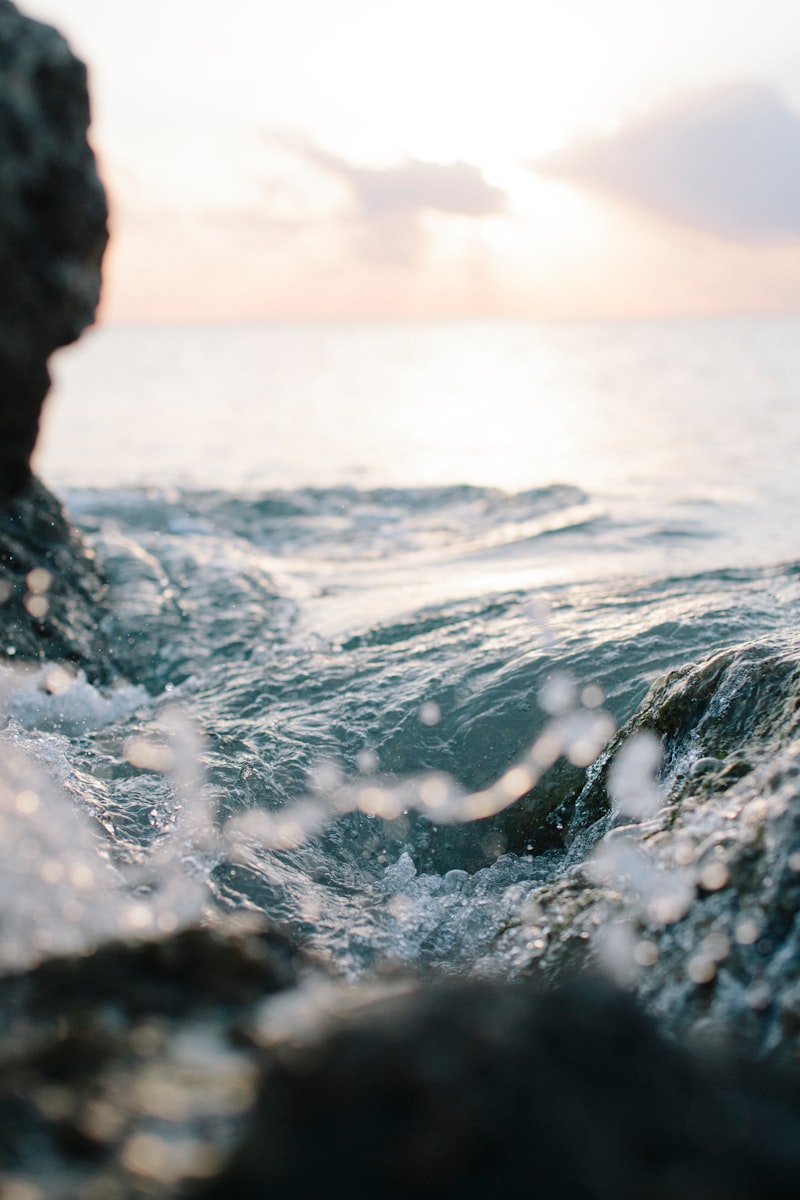Deep-sea microbial symbiosis is not just a survival tactic; it’s a testament to the resilience and interconnectedness of life forms in Earth’s most hostile realms. These symbiotic relationships often involve bacteria and archaea, each playing unique roles in sustaining fragile ecosystems miles beneath the surface. They cooperate, exchanging nutrients and metabolic by-products, essentially creating a microscopic economy where each participant benefits.
One of the most fascinating examples is found around hydrothermal vents, where superheated water laden with minerals gushes from the ocean floor. Here, chemosynthetic bacteria harness the energy from these minerals, supporting entire communities of organisms in an otherwise barren landscape. These bacteria form partnerships with tube worms and clams, providing them with essential nutrients while receiving a stable habitat in return.
In the dark depths of the ocean, symbiotic relationships take on even more innovative forms. From bioluminescent bacteria illuminating the path for deep-sea creatures to thermal vents nurturing entire ecosystems, these partnerships are marvels of evolution. They underscore the adaptability of life to thrive under conditions once thought uninhabitable.
Moreover, these deep-sea symbiotic marvels are not just scientific curiosities; they hold potential implications for biotechnology and medicine. Studying these partnerships could unlock new insights into antibiotic resistance, bioremediation, and even sustainable energy production.
Microbial symbiosis in deep-sea environments is a testament to nature’s ingenuity and resilience. As scientists delve deeper into these uncharted waters, each discovery illuminates the intricate web of life that exists far below the surface, reminding us of the interconnectedness of all living things on our planet.
Unveiling Nature’s Deep-Sea Partnerships: The Fascinating World of Microbial Symbiosis
In the dark and crushing depths where sunlight struggles to penetrate, life doesn’t just survive—it thrives in unexpected ways. Microbial symbiosis involves a delicate dance between different types of microorganisms, where they form alliances that benefit both parties. Imagine tiny bacteria and archaea working together like dynamic duos, exchanging nutrients and metabolic by-products in a symbiotic embrace.
These partnerships are not just about survival; they are about thriving in extreme conditions. Take for example the hydrothermal vents deep on the ocean floor. Here, thermophilic bacteria team up with other microbes to convert toxic hydrogen sulfide into usable energy through a process called chemosynthesis. This partnership not only sustains these organisms but also supports entire communities of unique marine life that depend on these vent ecosystems.
Another mesmerizing example of microbial symbiosis can be found in the guts of deep-sea creatures like the giant tube worms. These worms host bacteria in their bodies that help them digest nutrients from the chemically rich fluids emitted by hydrothermal vents. In return, the bacteria receive a safe habitat and a steady supply of nutrients from the host.
Understanding these partnerships is not only a scientific marvel but also holds promise for innovations in biotechnology and medicine. Researchers are exploring how the principles of microbial symbiosis can inspire new ways to treat diseases or engineer sustainable solutions.
In essence, microbial symbiosis in the deep sea showcases nature’s genius in fostering collaboration for mutual benefit. It challenges our understanding of life’s boundaries and opens doors to new possibilities in exploration and discovery. As we continue to unveil these partnerships, we uncover more about the resilience and interconnectedness of life in Earth’s most extreme environments.
Life Below the Surface: How Microbial Symbiosis Thrives in the Deep-Sea
Microbial symbiosis, the cooperative interaction between different microorganisms, plays a crucial role in sustaining life in these dark and cold waters. In this harsh environment, where resources are scarce and conditions are harsh, microbes have developed unique partnerships to survive and thrive.

One of the most fascinating examples of microbial symbiosis in the deep-sea is found around hydrothermal vents. These vents spew forth mineral-rich, superheated water from beneath the Earth’s crust, creating oases of life in the deep ocean. Here, chemosynthetic bacteria form the base of the food chain by harnessing the energy from chemicals such as hydrogen sulfide, instead of sunlight, to produce organic matter.
These bacteria, in turn, form symbiotic relationships with other organisms such as giant tube worms and clams. The bacteria reside within the tissues of these animals, providing them with essential nutrients in exchange for a safe habitat and a steady supply of chemicals. This mutually beneficial relationship allows both partners to thrive in an otherwise inhospitable environment.
Another example of deep-sea microbial symbiosis exists in the cold, nutrient-poor waters of the abyssal plains. Here, microbes form symbiotic partnerships with deep-sea animals like sponges and sea cucumbers. These animals filter feed and host microbial communities that aid in digestion and provide protection against pathogens, ensuring their survival in the deep-sea ecosystem.
Understanding microbial symbiosis in the deep-sea is not only crucial for unraveling the complexity of marine ecosystems but also holds promise for biotechnological advancements. The unique adaptations and biochemical processes developed by deep-sea microbes could inspire innovations in medicine, energy production, and environmental conservation.
As scientists continue to explore and study these extreme environments, they uncover new insights into the interconnectedness of life below the surface. The deep-sea remains a frontier of discovery, where microbial symbiosis exemplifies nature’s ability to thrive against all odds.
Secrets of the Abyss: Exploring Microbial Symbiosis in Deep-Sea Ecosystems
Imagine the depths of the ocean, where sunlight fades into darkness and pressure becomes immense. Here, where traditional sources of energy are scarce, microbial symbiosis emerges as a beacon of adaptation. This symbiotic relationship involves different microbial species working together, exchanging nutrients and metabolic by-products to sustain each other’s existence.
One of the most fascinating examples is found around hydrothermal vents, where extremophile bacteria and archaea thrive in the presence of chemicals like hydrogen sulfide. These microbes not only withstand extreme temperatures and pressures but also form symbiotic relationships with deep-sea organisms such as giant tube worms and clams. The microbes provide essential nutrients, while the host organisms offer shelter and a stable environment.
In another corner of the Abyss, microbial mats create vibrant ecosystems around methane seeps. These mats consist of diverse microbial communities that utilize methane as their energy source, forming complex food webs. They support a variety of life forms, from tiny crustaceans to mollusks, showcasing the power of microbial symbiosis in sustaining biodiversity in the deep ocean.
The study of microbial symbiosis in deep-sea ecosystems is not just about understanding biological relationships; it holds potential implications for biotechnology and medicine. Unique enzymes and metabolic pathways found in these symbiotic microbes could inspire innovations in biofuel production, pharmaceuticals, and environmental remediation.
As we delve deeper into the secrets of the Abyss, each discovery reveals new layers of complexity and beauty in the world’s oceans. Microbial symbiosis stands as a testament to nature’s resilience and creativity, showing us that even in the harshest environments, collaboration can lead to thriving ecosystems and unexpected marvels.
Survival Strategies in Extreme Depths: The Role of Microbial Symbiosis
Microbial symbiosis involves a delicate balance where each partner contributes something essential. For instance, in the hydrothermal vents deep in the ocean, bacteria harness chemical energy from minerals in the vent fluid through a process called chemosynthesis. This energy is then utilized by other organisms in the ecosystem, forming the base of the food chain in these lightless realms. Without this symbiotic relationship, these ecosystems simply wouldn’t exist as we know them.
Imagine these microbes as the architects and engineers of their environments, where they not only sustain life but also shape entire ecosystems. Their ability to thrive in extreme conditions—such as extreme temperatures, lack of sunlight, and high-pressure environments—is a testament to their adaptability and resilience.
Moreover, microbial symbiosis isn’t limited to deep-sea environments alone. Similar relationships are found in other extreme habitats on Earth, from acidic hot springs to Arctic permafrost. Each ecosystem has its own unique set of microbial players, adapting and evolving to their specific niche over millions of years.
Understanding these survival strategies at the microbial level not only sheds light on the diversity of life on our planet but also holds potential insights for applications in biotechnology, medicine, and environmental conservation. By studying how microbes survive and thrive in extreme depths, scientists gain valuable knowledge that could inform future strategies for sustainability and resilience in a rapidly changing world.
In essence, microbial symbiosis in extreme environments is a testament to the power of collaboration in nature, where organisms forge partnerships to overcome challenges that would be insurmountable alone. As we continue to explore and study these remarkable ecosystems, we uncover more about the interconnected web of life on Earth and the profound resilience of microbial communities.
Beyond Sunlight: Illuminating the Depths with Microbial Symbiosis
Have you ever wondered what lies beneath the sunlit surface of our oceans? Beneath the azure waves, a fascinating world thrives in darkness, where sunlight dares not penetrate. This mysterious realm is illuminated not by the sun, but by the extraordinary phenomenon of microbial symbiosis.
In the deep ocean, where sunlight fades into obscurity, life persists in ways that challenge our understanding of ecosystems. Here, microbial symbiosis plays a crucial role. Imagine a dance of life where tiny organisms forge partnerships that sustain entire communities. It’s a bit like a cosmic ballet, where each partner brings unique talents to the stage, creating a symphony of survival.
One of the most astounding examples of microbial symbiosis is between deep-sea tubeworms and their internal bacteria. These tubeworms, found near hydrothermal vents on the ocean floor, have no mouth or digestive system. Instead, they rely entirely on a species of chemosynthetic bacteria housed within their tissues. In return for a safe haven, the bacteria convert toxic chemicals from the vents into organic compounds that nourish the tubeworm. It’s a partnership so intimate that the worm cannot survive without its bacterial counterpart.
But microbial symbiosis isn’t limited to the abyssal plains. Even in more familiar environments, such as our own bodies, trillions of bacteria work in harmony with us, aiding digestion, bolstering immunity, and even influencing our mood. It’s a reminder that symbiotic relationships are not just a curiosity of nature’s extremes but a fundamental aspect of life on Earth.
As scientists delve deeper into these relationships, they uncover new insights into how life adapts and thrives in seemingly inhospitable conditions. The study of microbial symbiosis not only expands our understanding of ecosystems but also holds promise for innovations in biotechnology and medicine.
Next time you gaze upon the ocean, ponder the hidden world of microbial symbiosis. It’s a testament to nature’s resilience and creativity, where even in darkness, life finds a way to flourish.
Invisible Collaborators: Understanding Microbial Symbiosis in the Deep-Sea
Microbial symbiosis refers to the close interaction between different microorganisms, where they live together and benefit each other. In the deep-sea environment, where conditions are extreme and resources scarce, these symbiotic relationships are essential for survival. One of the most fascinating examples is between deep-sea tubeworms and their microbial partners.
Deep-sea tubeworms, found near hydrothermal vents on the ocean floor, rely entirely on chemosynthetic bacteria living within their tissues. These bacteria harness chemical energy from the vent fluids, converting it into organic compounds that feed both themselves and the tubeworm. In return, the tubeworm provides a safe harbor and a steady supply of chemicals for the bacteria to thrive.
This mutual dependency extends beyond tubeworms. Deep-sea clams, mussels, and other creatures form similar partnerships with microbial communities. These relationships are not just about survival but also about adaptation. Microbes help their hosts withstand extreme temperatures, high pressure, and toxic chemicals present in their environment.
Imagine these partnerships as alliances in an underwater city, where each member contributes to the community’s resilience and prosperity. Without these microbial symbionts, many deep-sea organisms would struggle to survive, let alone thrive in such harsh conditions.
Scientists continue to study these invisible collaborators to unravel their full impact on deep-sea ecosystems and their potential applications in biotechnology and medicine. Understanding microbial symbiosis in the deep-sea isn’t just about unlocking the secrets of the ocean; it’s about appreciating the interconnectedness of life in the most unexpected places.

As we delve deeper into the depths, the story of microbial symbiosis unfolds like a captivating mystery, revealing nature’s ingenious solutions to the challenges of survival in the deep-sea realm.
Frequently Asked Questions
What is microbial symbiosis in deep-sea environments?
Microbial symbiosis in deep-sea environments refers to mutually beneficial relationships between different microorganisms living in the extreme conditions of the deep ocean. These symbiotic interactions often involve unique adaptations that enable survival in high-pressure, low-light, and nutrient-poor environments. Understanding microbial symbiosis in deep-sea ecosystems is crucial for exploring biodiversity and ecological processes in these remote and challenging habitats.
How do microbes form symbiotic relationships in the deep sea?
Learn how microbes in the deep sea form symbiotic relationships where they cooperate with other organisms to survive and thrive in extreme conditions, such as providing essential nutrients or aiding in chemical reactions that benefit both partners.
How does microbial symbiosis contribute to biodiversity in the deep sea?
Learn how microbial symbiosis enhances biodiversity in the deep sea. Discover how these mutually beneficial relationships between microorganisms and deep-sea organisms support ecosystem stability and foster species diversity.
What are examples of symbiotic partnerships among deep-sea microbes?
Discover examples of symbiotic partnerships among deep-sea microbes, where species cooperate for survival. Examples include chemosynthetic bacteria living inside tubeworms and microbial consortia forming biofilms on hydrothermal vents.
What roles do symbiotic microbes play in deep-sea ecosystems?
Learn about the essential roles symbiotic microbes play in deep-sea ecosystems, from nutrient cycling to supporting diverse life forms.



